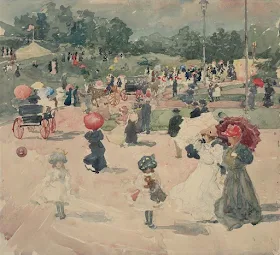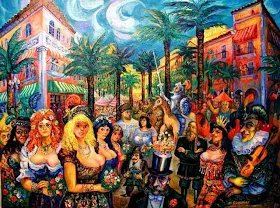Pieter Bruegel the Elder, Le Combat de Carnaval et Carême, The Battle Between Carnival and Lent,
1559, oil on panel, Kunsthistorisches Museum, Vienna.
Pieter Bruegel the Elder, The Battle Between Carnival and Lent, The figure of Carnival (detail), 1559
Pierre Bergaigne, A
Carnival Ball, 1652
Pierre Bergaigne, A
Carnival Parade With Masked Figures
Giovanni Domenico Tiepolo, Masks Carnival of Venice with Pantalone, c. 1740-50
Giovanni Domenico Tiepolo, Carnival Scene (The Minuet), between 1754 and 1755
Aleksandr-Petrovic Mjasoedo, Carnival in Rome, 1839
Adrien Moreau, The
Carnival Procession, 1887
James Ensor, Carnaval
sur la plage, Carnival on the beach, 1887

Νικόλαος Γύζης, Καρναβάλι στην Αθήνα, 1892

Georges Lemmen, Carnival, The Carousel, 1892


Νικόλαος Γύζης, Καρναβάλι στην Αθήνα, 1892

Georges Lemmen, Carnival, The Carousel, 1892

Maurice Prendergast, Carnival, Franklin Park, Boston, 1897
Paul Signac, Carnival at Nice
Lyonel Feininger, Carnival, 1908. Carnival, painted in
1908, soon after Feininger had begun to explore painting after a successful
career as an illustrator. Photograph: National Galerie, Staatliche Museen,
Berlin/MMFA
Lyonel Feininger, Carnival in Arcueil, 1911. Feininger's
work around this time often included a carnival world with larger-than-life
figures in vibrant colours. Photograph: The Art Institute of Chicago; Joseph
Winterbotham Collection/MMFA
James Ensor, Carnaval en Flandre, Carnival in Flanders,
1920
Max Beckmann, Carnival, 1920. Beckmann’s work, with
its grotesque and distorted figures, epitomised what the Nazis considered to be
‘degenerate’ art. He was dismissed from his teaching post in Frankfurt in 1933.
Several of his works were included in the 1937 Degenerate Art show, prompting
him to leave Germany for Amsterdam. This work represents the climax of
Carnival, a season of fancy dress parties, masked balls and street processions
with wild music and dancing. The two figures are based on close friends of the
artist, who is possibly represented by the masked clown.
Antonio Donghi, Carnevale, 1923, private collection. WikiArt.
Paul Klee, Carnival in the Mountains, 1924
Max Beckmann, Carnival:
The Artist and His Wife, 1925, Oil on canvas, 63 x 41 in. (160 x 105.5 cm), Kunstmuseum
der Stadt, Dusseldorf.
Stephan Lackner
writes: "The artist with his young bride Max and Quappi were married in
September 1925 are out for an evening's entertainment. They have gone to
considerable expense for preparations, and their costumes are chic and amusing.
They arrive through the parting flaps of a curtain as if they were stepping
onto a stage. Their faces are powdered and made up, and they obviously enjoy
the masquerade. Beckmann's usually stern mien has loosened up, his expression
is just on the threshold of a smile. He is proud of his pretty wife. Even
though they do not touch, the parallelism of their hands conveys a feeling of
harmony. The artist and his wife have made up their minds "to belong"
and to have a good time. The viewer partakes of their good humor. "The
color scheme is of tasteful subtlety. Primary colors are kept to a minimum. The
purple, greenish, and russet hues are mixed with great finesse and have a
velvety, highly cultured shimmer; in a word, the fabrics look aristocratic.
Even the horse is not a makeshift prop, but is a rather luxurious toy to serve
only for one evening.
"Quappi,
Beckmann's second wife, brought a light note into the tormented painter's life.
An excellent violinist, much younger than he, from a well-to-do family, and
very much in love, she may have been a distraction for the artist-moralist.
Only two years earlier, when Beckmann was asked whether he would paint some war
pictures, he replied: "Langst bin ich in anderen Kriegen" (I'm
already in different wars). He regarded his art as a spiritual combat. But in
1925, he suddenly seemed to have concluded an armistice with his deeper
problems. A great love of life inspired Beckmann at that time, and Quappi
helped him to enjoy the present. The Beckmanns were popular with the
artistically inclined society of Frankfurt, and Beckmann became the teacher of
a master class. It may be noted that later on, when Nazi persecution, exile,
hunger, cold, and danger changed their style of living, Quappi remained a most
efficient helpmate. "She is an angel," Beckmann said, "sent to
me so I could accomplish my work." "In 1925 this lay far in the
future. At the moment Max and Quappi are two figures from a new commedia
dell'arte: harlequin and a lovely horsewoman with a funny hat.
"Illusion and
reality melt into each other; there is no strict borderline between the two
worlds, certainly not during carnival time. Beckmann often endeavored to
confound the two spheres. Painting carnival and circus scenes, masquerades and
costume parties, he found a whimsical way of philosophizing: Don't trust
appearances, things and people are not what they seem to be. But Beckmann was
willing to adhere to the rules of society's game-especially when it was an
amusement."
Jose Gutierrez Solana, The Carnival, 1928
Felix Labisse, Grand
carnival Ostendais, 1934
Max Beckmann, Carnival, oil on canvas triptych, 1943
John Thiering, Carnival Of Animals
Ari Roussimoff, Carnival in Miami, 2004. One of the most
picturesque areas in Miami Beach is called Espanola Way. In this work I used
the sensuous, almost exotic neighborhood setting as a backdrop for a Carnival,
timeless in spirit. This area with its unique old-world Spanish architecture
added much to what I see as Miami Beach's European aura. In this composition I
placed a host of figures from the carnival, the circus and the sideshows. There
are Jesters, dancing Pinheads, a Bearded Lady, Jo-Jo the Russian Dog Faced Man,
a Magician as well as the great 17th century Spanish old master Velasquez, Don
Quixote and Sancho Panza.



+A+Carnival+Parade+With+Masked+Figures.jpg)


.jpg)
.jpg)


















